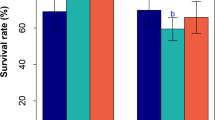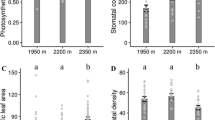Abstract
Vines depend on external support to prevent shading by neighbouringplants. Hence, it is important to determine whether shading enhances thephenotypic responses of vines to support availability. I evaluated theconsequences of support availability (a vertical stake) on shoot and leaftraitsof the morning glory Ipomoea purpurea (Convolvulaceae)under full sunlight and extreme shade. It was hypothesised that phenotypicresponses of vines to support availability should be greater in the shade. Inaddition, to investigate possible constraints to such phenotypic responses, thecorrelations among phenotypic traits and the plasticity of such correlationswere evaluated. The phenotypic variation of the main stem length and of thenumber of branches was consistent with the hypothesis, i.e. greater responsestosupport availability in the shade. In contrast, both internode length and leafarea (two traits that showed a significant and positive correlation) decreasedin the sun and increased in the shade with support availability. Petiole lengthdecreased with support in the sun but had no response in the shade. On theotherhand, the number of significant trait correlations found in plants in the sunand supported plants was higher than those of shade and non-supported plants,respectively. Several of the correlations were significantly sensitive to theenvironment. Flowering only occurred in the sun treatment. Whereas no shoot orleaf trait was significantly correlated with flower number in supported plants,both petiole length and shoot biomass showed a significant correlation withsuchestimate of plant fitness in non-supported plants.
Similar content being viewed by others
References
Austin D.F. and Huamán Z. 1996. A synopsis of Ipomoea (Convolvulaceae) in the Americas. Taxon 45: 3–38.
Ballaré C.L. 1994. Light gaps: sensing the light opportunities in highly dynamic canopy environments. In: Caldwell M.M. and Pearcy R.W. (eds), Exploitation of Heterogeneity by Plants. Academic Press, London, pp. 73–110.
Bazzaz F.A. and Harper J.L. 1977. Demographic analysis of growth of Linum usitatissimum. New Phytologist 78: 193–208.
Cipollini D.F. and Schultz J.C. 1999. Exploring cost constraints on stem elongation in plants using phenotypic manipulation. American Naturalist 153: 236–242.
Darwin C.R. 1875. The Movements and Habits of Climbing Plants. John Murray, London.
Den Dubbelden K.C., Koen C. and Verburg R.W. 1996. Inherent allocation patterns and potential growth rates of herbaceous climbing plants. Plant and Soil 184: 341–347.
Den Dubbelden K.C. and Oosterbeek B. 1995. The availability of external support affects allocation patterns and morphology of herbaceous climbing plants. Functional Ecology 9: 628–634.
Dudley S.A. and Schmitt J. 1996. Testing the adaptive plasticity hypothesis: density-dependent selection on manipulated stem length in Impatiens capensis. American Naturalist 147: 445–465.
Ellison A.M. and Niklas K.J. 1988. Branching patterns of Salicornia europaea (Chenopodiaceae) at different successional stages: a comparison of theoretical and real plants. American Journal of Botany 75: 501–512.
French J.C. 1977. Growth relationships of leaves and internodes in viny angiosperms with different modes of attachment. American Journal of Botany 64: 292–304.
Gartner B.L. 1991a. Structural stability and architecture of vines vs. shrubs of poison oak, Toxicodendron diversilobum. Ecology 72: 2005–2015.
Gartner B.L. 1991b. Relative growth rate of vines and shrubs of western poison oak, Toxicodendron diversilobum (Anacardiaceae). American Journal of Botany 78: 1345–1353.
Gianoli E. 2001. Lack of differential plasticity to shading of internodes and petioles with growth habit in Convolvulus arvensis (Convolvulaceae). International Journal of Plant Sciences 162: 1247–1252.
Gianoli E. and Hannunen S. 2000. Plasticity of leaf traits and insect herbivory in Solanum incanum L. (Solanaceae) in Nguruman, SW Kenya. African Journal of Ecology 38: 183–187.
Huber H. 1996. Plasticity of internodes and petioles in prostrate and erect Potentilla species. Functional Ecology 10: 401–409.
Huber H., Fijan A. and During H.J. 1998. A comparative study of spacer plasticity in erect and stoloniferous herbs. Oikos 81: 576–586.
Klimeš L. and Klimešová J. 1994. Biomass allocation in a clonal vine: effects of intraspecific competition and nutrient availability.Folia Geobotanica et Phytotaxonomica 29: 237–244.
Larson K.C. 2000. Circumnutation behavior of an exotic honeysuckle vine and its native congener: influence on clonal mobility.American Journal of Botany 87: 533–538.
Lechowicz M.J. and Blais P.A. 1988. Assessing the contributions of multiple interacting traits to plant reproductive success: environmental dependence. Journal of Evolutionary Biology 1: 255–273.
Matista A.A. and Silk W.K. 1997. An electronic device for continuous, in vivo measurement of forces exerted by twining vines. American Journal of Botany 84: 1164–1168.
Matthei O. 1995. Manual De Las Malezas Que Crecen en Chile. Alfabeta, Santiago.
Peñalosa J. 1983. Shoot dynamics and adaptive morphology of Ipomoea phillomega (Vell.) House (Convolvulaceae), a tropical rainforest liana. Annals of Botany 52: 737–754.
Pigliucci M. and Schlichting C.D. 1995. Ontogenetic reaction norms in Lobelia siphilitica (Lobeliaceae): response to shading. Ecology 76: 2134–2144.
Pigliucci M. and Schlichting C.D. 1996. Reaction norms of Arabidopsis. IV. Relationships between plasticity and fitness. Heredity 76: 427–436.
Pigliucci M., Schlichting C.D. and Whitton J. 1995. Reaction norms of Arabidopsis. II Response to stress and unordered environmental variation. Functional Ecology 9: 537–547.
Puntieri J.G. and Pyšek P. 1993. The effects of physical support and density on biomass production and size hierarchies of Galium aparine populations. Oikos 66: 279–284.
Putz F.E. 1984. The natural history of lianas on Barro Colorado island, Panamá. Ecology 65: 1713–1724.
Putz F.E. and Chai P. 1987. Ecological studies of lianas in Lamber national park, Sarawak, Malaysia. Journal of Ecology 75: 523–531.
Putz F.E. and Holbrook N.M. 1991. Biomechanical studies of vines. In: Putz F.E. and Mooney H.A. (eds), The Biology of Vines. Cambridge University Press, Cambridge, pp. 73–97.
Putz F.E. and Mooney H.A. 1991. The Biology of Vines. Cambridge University Press, Cambridge.
Ray T.S. 1992. Foraging behaviour in tropical herbaceous climbers (Araceae). Journal of Ecology 80: 189–203.
Schlichting C.D. 1986. The evolution of phenotypic plasticity in plants. Annual Review of Ecology & Systematics 17: 667–693.
Schlichting C.D. 1989. Phenotypic plasticity in Phlox. II. Plasticity of character correlations. Oecologia 78: 496–501.
Schlichting C.D. and Pigliucci M. 1995. Lost in phenotypic space: environment-dependent morphology in Phlox drummondii (Polemoniaceae). International Journal of Plant Sciences 156: 542–546.
Schlichting C.D. and Pigliucci M. 1998. Phenotypic Evolution: A Reaction Norm Perspective. Sinauer, Sunderland.
Schmitt J. and Wulff R.D. 1993. Light spectral quality, phytochrome, and plant competition. Trends in Ecology & Evolution 8: 47–51.
Schweitzer J.A. and Larson K.C. 1999. Greater morphological plasticity of exotic honeysuckle species may make them better invaders than native species. Journal of the Torrey Botanical Society 126: 15–23.
Silk W.K. and Hubbard W.K. 1991. Axial forces and normal distributed loads in twinning stems of morning glory. Journal of Biomechanics 24: 599–606.
Sokal R.R. and Rohlf F.J. 1995. Biometry. Freeman, New York.
Stanton M.L., Roy B.A. and Thiede D.A. 2000. Evolution in stressful environments. I. Phenotypic variability, phenotypic selection, and response to selection in five distinct environmental stresses. Evolution 54: 93–111.
Sultan S.E., Wilczek A.M., Bell D.L. and Hand G. 1998. Physiological response to complex environments in annual Polygonum species of contrasting ecological breadth. Oecologia 115: 564–578.
Author information
Authors and Affiliations
Corresponding author
Rights and permissions
About this article
Cite this article
Gianoli, E. Phenotypic responses of the twining vine Ipomoea purpurea (Convolvulaceae) to physical support availability in sun and shade. Plant Ecology 165, 21–26 (2003). https://doi.org/10.1023/A:1021412030897
Issue Date:
DOI: https://doi.org/10.1023/A:1021412030897




